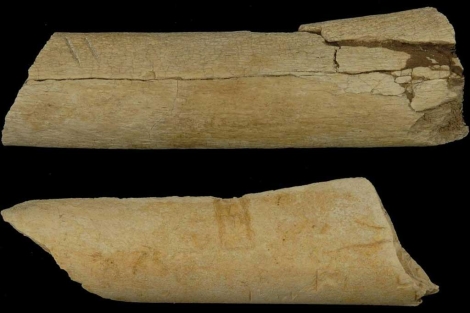Cuando Shannon McPherron, del Instituto Max Planck de Antropología Evolutiva de Alemania y el etíope Zeresenay Alemseged, de la Academia de Ciencias de California dieron a conocer en Nature el descubrimiento de una costilla de un mamífero del tamaño de una vaca y el fémur de un antílope con señales de marcas de cuchillos líticos se había hecho un gran descubrimiento. Las herramientas más antiguas conocidas tienen una antigüedad de
2,6 ó 2,5 millones de años, sin embargo las marcas de estos mamíferos indicaban un millón de años antes, posiblemente por los congeneres de "Lucy" conocidos como Australopithecus afarensis. La importancia de este descubrimiento es que se atribuía una capacidad humana como es fabricar utensilios de piedra, a una especie de homínido que no pertenece a nuestro genero Homo. Australopithecus afarensis tiene una capacidad craneana mucho menor que Homo.
Manuel Domínguez-Rodrigo publica un trabajo en la prestigiosa revista norteamericana Proceedings of the National Academy of Sciences (PNAS) donde propone que estas marcas son el resultado del pisoteo por otros animales en un suelo de grava, y no debido a una actividad carnívora. La morfología de los cortes, según este investigador, es más coherente con las marcas producidas por el pisoteo. Por tanto, no se retrasaría un millón de años la capacidad humana de fabricar herramientas. Según este autor, es más coherente que la fabricación de herramientas comenzará hace 2,5 millones de años, a la vez que se adquirió un mayor cerebro, que en paralelo evolucionaría hacía el consumo de carne.
Os adjuntamos el resumen para los más forofos
The announcement of two approximately 3.4-million-y-old purportedly butchered fossil bones from the Dikika paleoanthropological research area (Lower Awash Valley, Ethiopia) could profoundly alter our understanding of human evolution. Butchering damage on the Dikika bones would imply that tool-assisted meat-eating began approximately 800,000 y before previously thought, based on butchered bones from 2.6- to 2.5-million-y-old sites at the Ethiopian Gona and Bouri localities. Further, the only hominin currently known from Dikika at approximately 3.4 Ma is Australopithecus afarensis, a temporally and geographically widespread species unassociated previously with any archaeological evidence of butchering. Our taphonomic configurational approach to assess the claims of A. afarensis butchery at Dikika suggests the claims of unexpectedly early butchering at the site are not warranted. The Dikika research group focused its analysis on the morphology of the marks in question but failed to demonstrate, through recovery of similarly marked in situ fossils, the exact provenience of the published fossils, and failed to note occurrences of random striae on the cortices of the published fossils (incurred through incidental movement of the defleshed specimens across and/or within their abrasive encasing sediments). The occurrence of such random striae (sometimes called collectively “trampling” damage) on the two fossils provide the configurational context for rejection of the claimed butchery marks. The earliest best evidence for hominin butchery thus remains at 2.6 to 2.5 Ma, presumably associated with more derived species than A. afarensis.
2,6 ó 2,5 millones de años, sin embargo las marcas de estos mamíferos indicaban un millón de años antes, posiblemente por los congeneres de "Lucy" conocidos como Australopithecus afarensis. La importancia de este descubrimiento es que se atribuía una capacidad humana como es fabricar utensilios de piedra, a una especie de homínido que no pertenece a nuestro genero Homo. Australopithecus afarensis tiene una capacidad craneana mucho menor que Homo.
Manuel Domínguez-Rodrigo publica un trabajo en la prestigiosa revista norteamericana Proceedings of the National Academy of Sciences (PNAS) donde propone que estas marcas son el resultado del pisoteo por otros animales en un suelo de grava, y no debido a una actividad carnívora. La morfología de los cortes, según este investigador, es más coherente con las marcas producidas por el pisoteo. Por tanto, no se retrasaría un millón de años la capacidad humana de fabricar herramientas. Según este autor, es más coherente que la fabricación de herramientas comenzará hace 2,5 millones de años, a la vez que se adquirió un mayor cerebro, que en paralelo evolucionaría hacía el consumo de carne.
Os adjuntamos el resumen para los más forofos
The announcement of two approximately 3.4-million-y-old purportedly butchered fossil bones from the Dikika paleoanthropological research area (Lower Awash Valley, Ethiopia) could profoundly alter our understanding of human evolution. Butchering damage on the Dikika bones would imply that tool-assisted meat-eating began approximately 800,000 y before previously thought, based on butchered bones from 2.6- to 2.5-million-y-old sites at the Ethiopian Gona and Bouri localities. Further, the only hominin currently known from Dikika at approximately 3.4 Ma is Australopithecus afarensis, a temporally and geographically widespread species unassociated previously with any archaeological evidence of butchering. Our taphonomic configurational approach to assess the claims of A. afarensis butchery at Dikika suggests the claims of unexpectedly early butchering at the site are not warranted. The Dikika research group focused its analysis on the morphology of the marks in question but failed to demonstrate, through recovery of similarly marked in situ fossils, the exact provenience of the published fossils, and failed to note occurrences of random striae on the cortices of the published fossils (incurred through incidental movement of the defleshed specimens across and/or within their abrasive encasing sediments). The occurrence of such random striae (sometimes called collectively “trampling” damage) on the two fossils provide the configurational context for rejection of the claimed butchery marks. The earliest best evidence for hominin butchery thus remains at 2.6 to 2.5 Ma, presumably associated with more derived species than A. afarensis.
LUGAR Etiopía



















